Microstructural Evolution and Mechanical Properties of Graphene Oxide-Reinforced Ti6Al4V Matrix Composite Fabricated Using Spark Plasma Sintering
Abstract
1. Introduction
2. Materials and Methods
3. Results and Discussion
3.1. Microstructure Characteraziation of the Composites
3.2. Mechanical Properties of the Composites
4. Conclusions
- As compared with the typical Widmanstätten microstructure in the monolithic TC4 sample, the high residual tensile stress generated from the mismatch of coefficients of thermal expansion (CTE) between GO and TC4 was responsible for the presence of the typical basket-weave in the matrix microstructure of the composites. More importantly, an in situ-formed local TiC nanolayer and diffusion layer were identified at the GO–TC4 interface.
- In comparison with the TC4 sample, the 0.27GO/TC4 composite exhibited an improved strength (yield strength of 921.8 MPa and ultimate tensile strength of 1040.1 MPa) and a similar elongation of 5.3%, achieving a better balance between strength and ductility.
- The enhanced strength is closely related to the synergetic strengthening mechanisms such as Orowan strengthening, enhanced dislocation density strengthening, and load transfer, in which the improved interfacial bonding between the nanofiller and TC4 matrix due to the presence of a TiC nanolayer and diffusion layer at the interface makes load transfer greatly responsible for the enhanced strength of the composites.
Author Contributions
Funding
Institutional Review Board Statement
Informed Consent Statement
Data Availability Statement
Acknowledgments
Conflicts of Interest
References
- Henriques, V.A.R.; de Campos, P.P.; Cairo, C.A.A.; Bressiani, J.C. Production of titanium alloys for advanced aerospace systems by powder metallurgy. Mater. Res. 2005, 8, 443–446. [Google Scholar] [CrossRef]
- Hu, Y.; Cong, W.; Wang, X.; Li, Y.; Ning, F.; Wang, H. Laser deposition-additive manufacturing of TiB-Ti composites with novel three-dimensional quasi-continuous network microstructure: Effects on strengthening and toughening. Compos. B 2018, 133, 91–100. [Google Scholar] [CrossRef]
- Hayat, M.D.; Singh, H.; He, Z.; Cao, P. Titanium metal matrix composites: An overview. Compos. A 2019, 121, 418–438. [Google Scholar] [CrossRef]
- Abe, J.O.; Popoola, A.P.; Popoola, O.M. Consolidation of Ti6Al4V alloy and refractory nitride nanoparticles by spark plasma sintering method: Microstructure, mechanical, corrosion and oxidation characteristics. Mater. Sci. Eng. A 2020, 774, 138920. [Google Scholar] [CrossRef]
- Abe, J.O.; Popoola, A.P.; Popoola, O.M. Influence of varied process parameters on the microstructure, densification and microhardness of spark plasma sintered Ti-6Al-4V/h-BN binary composite. In Proceedings of the 2019 6th International Conference on Mechanical, Materials and Manufacturing, Boston, MA, USA, 12–14 October 2019; IOP Conference Series: Materials Science and Engineering; IOP Publishing Ltd.: Bristol, UK, 2019; Volume 689, pp. 1–7. [Google Scholar]
- Adebiyi, D.I.; Popoola, A.P. Mitigation of abrasive wear damage of Ti–6Al–4V by laser surface alloying. Mater. Des. 2015, 74, 67–75. [Google Scholar] [CrossRef]
- Shang, C.Y.; Zhang, F.M.; Zhang, B.; Chen, F. Interface microstructure and strengthening mechanisms of multilayer graphene reinforced titanium alloy matrix composites with network architectures. Mater. Des. 2020, 196, 109119. [Google Scholar] [CrossRef]
- Luo, S.D.; Li, Q.; Tian, J.; Wang, C.; Yan, M.; Schaffer, G.B. Self-assembled, aligned TiC nanoplatelet-reinforced titanium composites with outstanding compressive properties. Scr. Mater. 2013, 69, 29–32. [Google Scholar] [CrossRef]
- Yan, Z.; Feng, C.; Cai, Y.; Zheng, Y. Microstructure and mechanical properties of in-situ synthesized TiB whiskers reinforced titanium matrix composites by high-velocity compaction. Powder Technol. 2014, 267, 309–314. [Google Scholar] [CrossRef]
- Li, S.; Kondoh, K.; Imai, H.; Chen, B.; Jia, L.; Umeda, J. Microstructure and mechanical properties of P/M titanium matrix composites reinforced by in-situ synthesized TiC–TiB. Mater. Sci. Eng. A 2015, 628, 75–83. [Google Scholar] [CrossRef]
- Lacoste, E.; Arvieu, C.; Quenisset, J.M. Correlation between microstructures of SiCreinforced titanium matrix composite and liquid route processing parameters. J. Mater. Sci. 2015, 50, 5583–5592. [Google Scholar] [CrossRef]
- Han, C.; Li, Y.C.; Liang, X.G.; Chen, L.P.; Zhao, N.; Zhu, X.K. Effect of composition and sintering temperature on mechanical properties of ZrO2 particulate-reinforced titanium-matrix composite. Trans. Nonferrous Metals Soc. China 2012, 22, 1855–1859. [Google Scholar] [CrossRef]
- Jiao, Y.; Huang, L.J.; Wang, S.X.; Li, T.; An, Q.; Cui, X.P. Effects of first-scale TiBw on secondary-scale Ti5Si3 characteristics and mechanical properties of in-situ (Ti5Si3+TiBw)/Ti6Al4V composites. J. Alloys Compd. 2017, 704, 269–281. [Google Scholar] [CrossRef]
- Tjong, S.C.; Mai, Y.W. Processing-structure-property aspects of particulate- and whisker-reinforced titanium matrix composites. Compos. Sci. Technol. 2008, 68, 583–601. [Google Scholar] [CrossRef]
- Huang, L.J.; Geng, L.; Li, A.B.; Yang, K.F.; Peng, X.H. In situ TiBw/Ti–6Al–4V composites with novel reinforcement architecture fabricated by reaction hot pressing. Scr. Mater. 2009, 60, 996–999. [Google Scholar] [CrossRef]
- Geim, A.K.; Novoselov, K.S. The rise of graphene. Nat. Mater. 2017, 6, 183–191. [Google Scholar] [CrossRef] [PubMed]
- Balandin, A.A.; Ghosh, S.; Bao, W.; Calizo, I.; Teweldebrhan, D.; Miao, F.; Lau, C.N. Superior Thermal Conductivity of Single-Layer Graphene. Nano Lett. 2008, 8, 902–907. [Google Scholar] [CrossRef]
- Zhu, Y.; Murali, S.; Cai, W.; Li, X.; Suk, J.W.; Potts, J.R.; Ruoffff, R.S. Graphene and Graphene Oxide: Synthesis, Properties, and Applications. Adv. Mater. 2010, 22, 3906–3924. [Google Scholar] [CrossRef]
- Tjong, S.C. Recent progress in the development and properties of novel metal matrix composites reinforced with carbon and graphene nanosheets. Mater. Sci. Eng. R 2013, 74, 281–350. [Google Scholar] [CrossRef]
- Zhang, H.P.; Cong, X.; Xiao, W.L.; Ameyama, K.; Ma, C.L. Enhanced mechanical properties of Al5083 alloy with graphene nanoplates prepared by ball milling and hot extrusion. Mater. Sci. Eng. A 2016, 658, 8–15. [Google Scholar] [CrossRef]
- Vasanthakumar, K.; Ghosh, S.; Koundinya, N.T.B.N.; Ramaprabhu, S.; Bakshi, S.R. Synthesis and mechanical properties of TiCX and Ti(C,N) reinforced titanium matrix in situ composites by reactive spark plasma sintering. Mater. Sci. Eng. A 2019, 759, 30–39. [Google Scholar] [CrossRef]
- Xu, Z.S.; Shi, X.L.; Zhai, W.Z.; Yao, J.; Song, S.Y.; Zhang, Q.X. Preparation and tribological properties of TiAl matrix composites reinforced by multilayer graphene. Carbon 2014, 67, 168–177. [Google Scholar] [CrossRef]
- Dong, L.L.; Xiao, B.; Liu, Y.; Li, Y.L.; Fu, Y.Q.; Zhao, Y.Q.; Zhang, Y.S. Sintering effect on microstructural evolution and mechanical properties of spark plasma sintered Ti matrix composites reinforced by reduced graphene oxide. Ceram. Int. 2018, 44, 17835–17844. [Google Scholar] [CrossRef]
- Liu, J.; Wu, M.; Yang, Y.; Yang, G.; Yan, H.; Jiang, K. Preparation and mechanical performance of graphene platelet reinforced titanium composites for high temperature applications. J. Alloys Compd. 2018, 765, 1111–1118. [Google Scholar] [CrossRef]
- Chen, H.; Mi, G.B.; Li, P.J.; Huang, X.; Cao, C.X. Microstructure and tensile properties of graphene-oxide-reinforced high-temperature titanium-alloy-matrix composites. Materials 2020, 13, 3358. [Google Scholar] [CrossRef] [PubMed]
- Stankovich, S.; Dikin, D.A.; Dommett, G.H.B.; Kohlhaas, K.M.; Zimney, E.J.; Stach, E.A.; Piner, R.D.; Nguyen, S.T.; Ruoff, R.S. Graphene-based composite materials. Nature 2006, 442, 282–286. [Google Scholar] [CrossRef] [PubMed]
- Lin, D.; Liu, C.R.; Cheng, G.J. Single-layer graphene oxide reinforced metal matrix composites by laser sintering: Microstructure and mechanical property enhancement. Acta Mater. 2014, 80, 183–193. [Google Scholar] [CrossRef]
- Song, Y.; Chen, Y.; Liu, W.W.; Li, W.L.; Wang, Y.G.; Liu, X.B. Microscopic mechanical properties of titanium composites containing multi-layer graphene nanofillers. Mater. Des. 2016, 109, 256–263. [Google Scholar] [CrossRef]
- Huang, L.J.; Geng, L.; Xu, H.Y.; Peng, H.X. In situ TiC particles reinforced Ti6Al4V matrix composite with a network reinforcement architecture. Mater. Sci. Eng. A 2011, 528, 2859–2862. [Google Scholar] [CrossRef]
- Huang, X.; Gao, Y.; Wang, Z.P.; Yi, Y.L.; Wang, Y.R. Microstructure, mechanical properties and strengthening mechanisms of in-situ prepared (Ti5Si3 + TiC0.67)/TC4 composites. J. Alloys. Compd. 2019, 792, 907–917. [Google Scholar] [CrossRef]
- Zhang, Y.; Chang, G.; Liu, S.; Tian, J.Q.; Wang, L.; Lu, W.B.; Qin, X.Y.; Sun, X.P. Microwave assisted, environmentally friendly, one pot preparation of Pd nanoparticles/graphene composites and their application in electrocatalytic oxidation of methanol. Catal. Sci. Technol. 2011, 1, 1636–1640. [Google Scholar] [CrossRef]
- Murr, L.E.; Esquivel, E.V.; Quinones, S.A. Microstructures and mechanical properties of electron beam-rapid manufactured Ti–6Al–4V biomedical prototypes compared to wrought Ti–6Al–4V. Mater. Charact. 2009, 60, 96–105. [Google Scholar] [CrossRef]
- Dong, L.L.; Lu, J.W.; Fu, Y.Q.; Hou, W.T.; Lin, Y.; Li, D.D.; Zhang, Y.S. Carbonaceous nanomaterial reinforced Ti-6Al-4V matrix composites: Properties, interfacial structures and strengthening mechanisms. Carbon 2020, 164, 272–286. [Google Scholar] [CrossRef]
- De Barros, M.I.; Rats, D.; Vandenbulcke, L.; Farges, G. Influence of internal diffusion barriers on carbon diffusion in pure titanium and Ti6Al4V during diamond deposition. Diam. Relat. Mater. 1999, 8, 1022–1032. [Google Scholar] [CrossRef]
- Li, J.; Zhang, X.; Geng, L. Effect of heat treatment on interfacial bonding and strengthening efficiency of graphene in GNP/Al composites. Compos. A 2019, 121, 487–498. [Google Scholar] [CrossRef]
- Cao, C.; Daly, M.; Singh, C.V.; Sun, Y.; Filleter, T. High strength measurement of monolayer graphene oxide. Carbon 2015, 81, 497–504. [Google Scholar] [CrossRef]
- Asgharzadeh, H.; Eslami, S. Effect of reduced graphene oxide nanoplatelets content on the mechanical and electrical properties of copper matrix composite. J. Alloys Compd. 2019, 806, 553–565. [Google Scholar] [CrossRef]
- Kim, W.J.; Lee, T.J.; Han, S.H. Multi-layer graphene/copper composites: Preparation using high-ratio differential speed rolling, microstructure and mechanical properties. Carbon 2014, 69, 55–65. [Google Scholar] [CrossRef]
- Arsenault, R.J.; Shi, N. Dislocation generation du to differences between the coefficients of thermal expansion. Mater. Sci. Eng. 1986, 81, 175–187. [Google Scholar] [CrossRef]

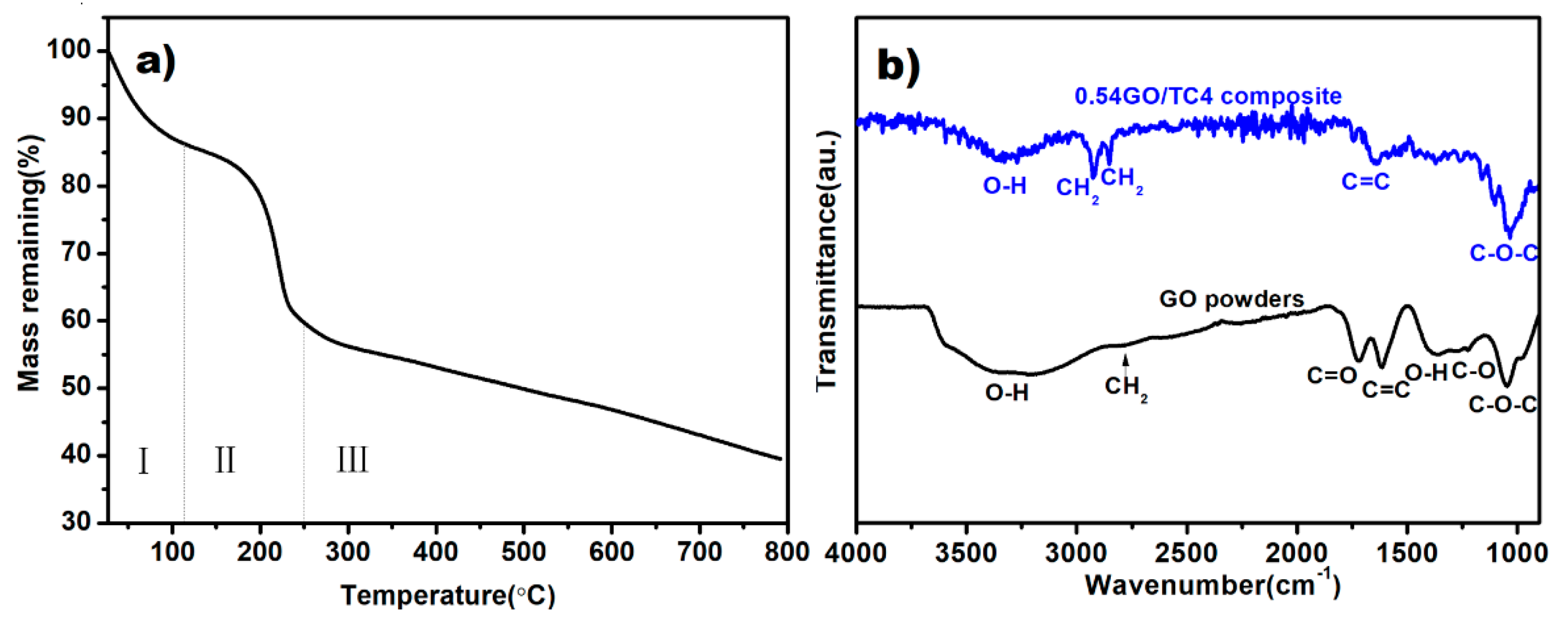
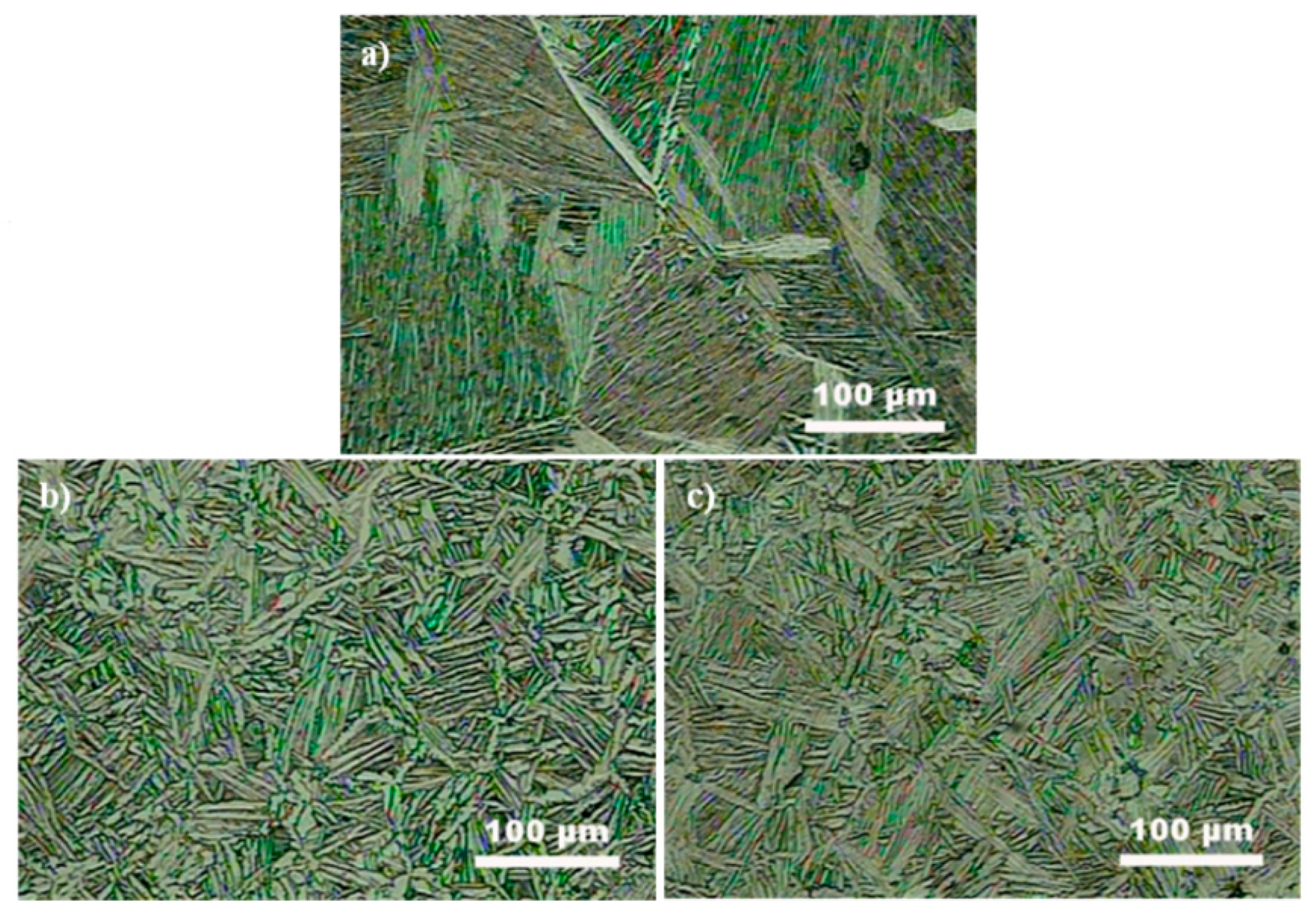
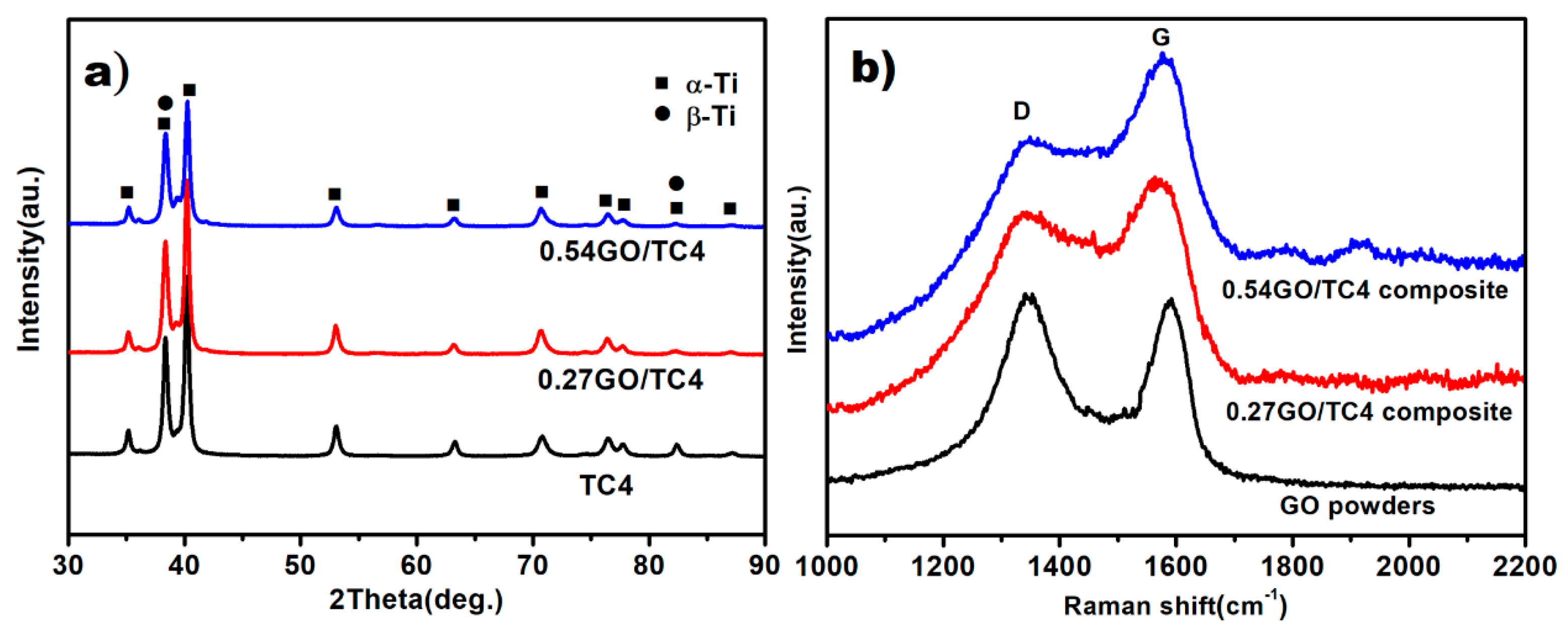

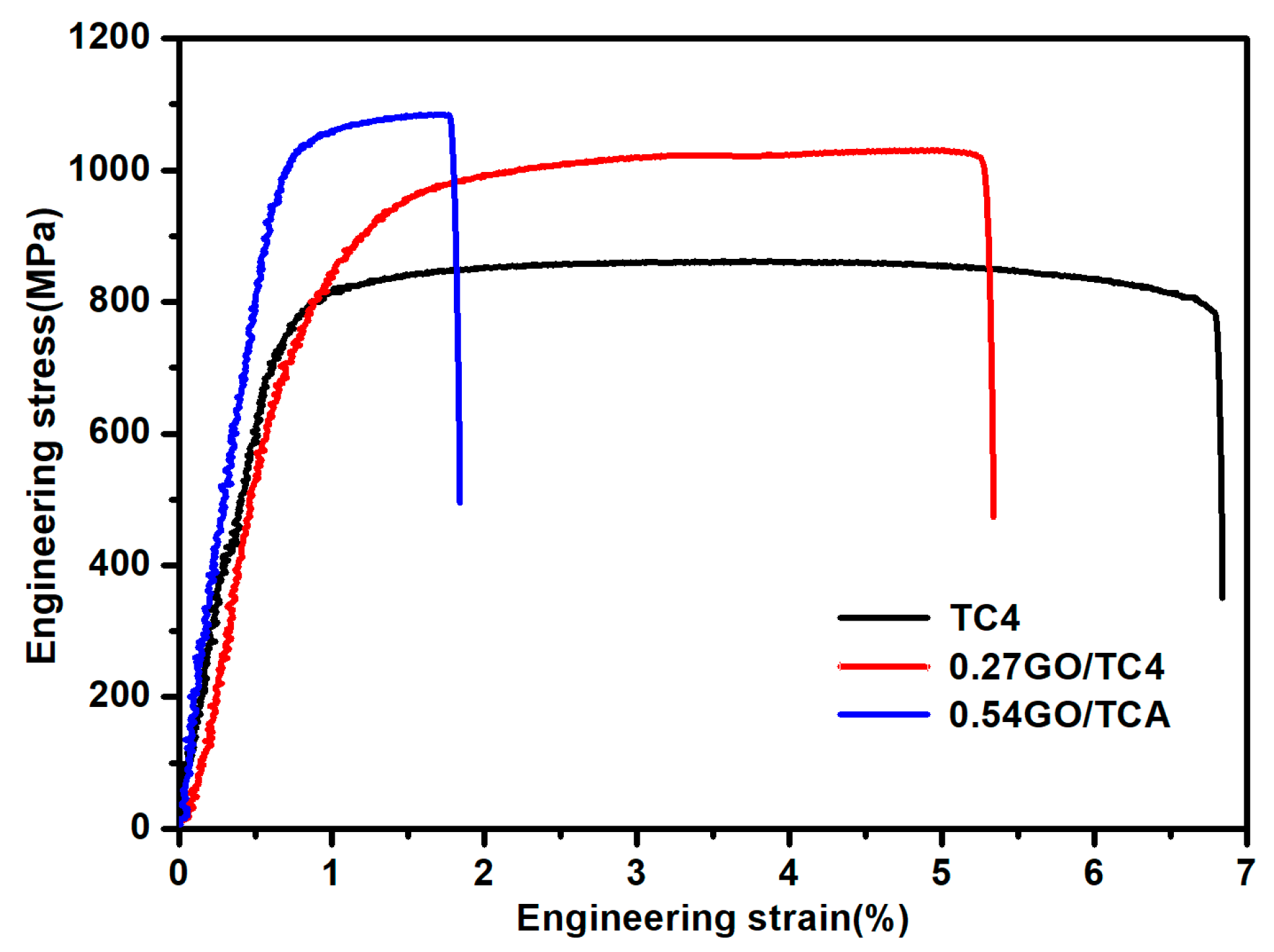
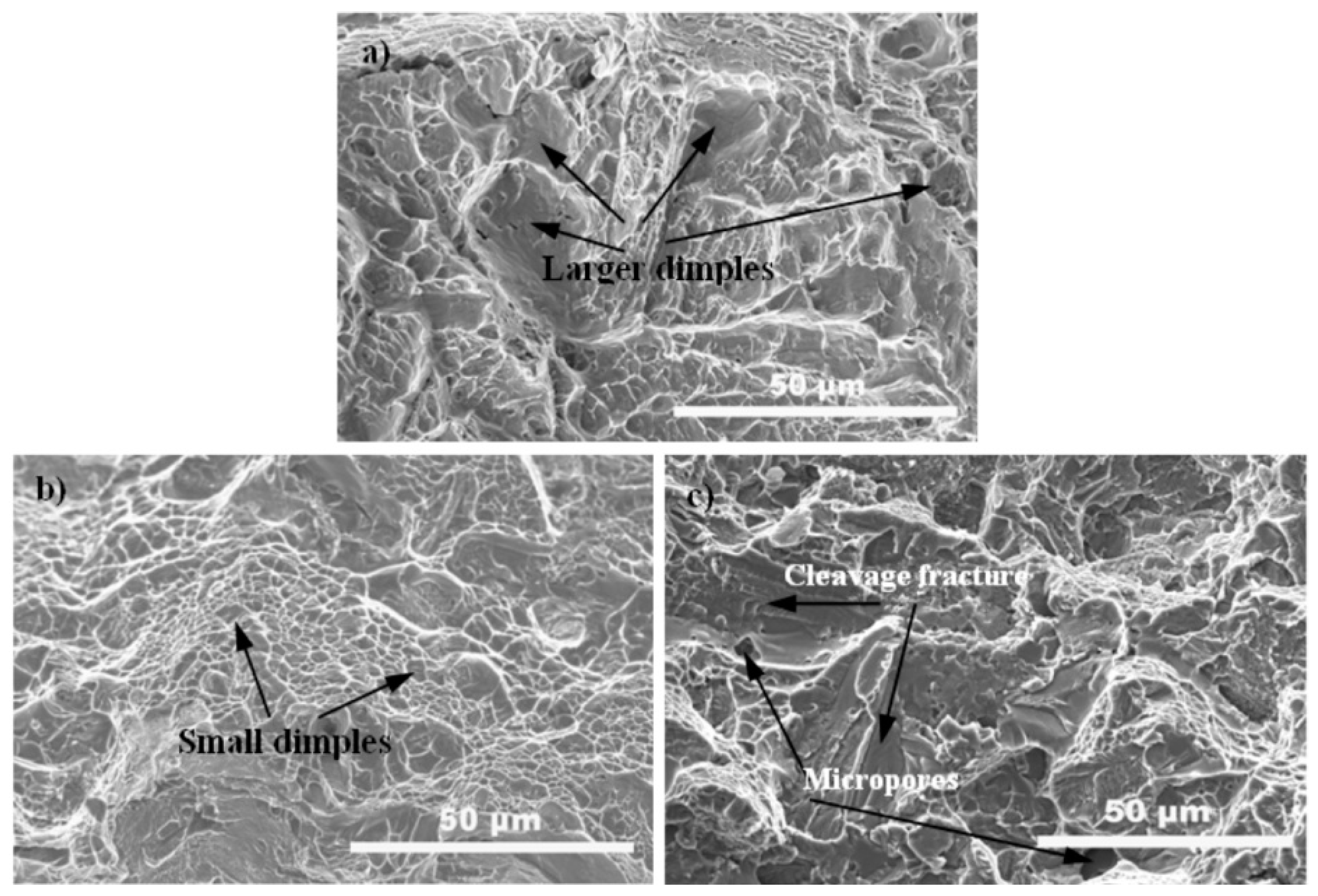
| Samples | E (GPa) | YS (MPa) | UTS (MPa) | ε (%) |
|---|---|---|---|---|
| TC4 | 110.5 ± 5.4 | 790.7 ± 3.3 | 855.7 ± 15.6 | 6.8 ± 0.7 |
| 0.27GO/TC4 | 123.4 ± 3.7 | 921.8 ± 5.3 | 1040.1 ± 8.5 | 5.3 ± 0.6 |
| 0.54GO/TC4 | 133.3 ± 3.2 | 1034 ± 4.5 | 1053.4 ± 27.4 | 1.8 ± 0.5 |
| Sample | Δσorowan | ΔσEDD | ΔσLT | Δσcal | Δσexp | Δσcal-exp |
|---|---|---|---|---|---|---|
| 0.27GO/TC4 | 2.7 | 15.6 | 117.7 | 136.0 | 131.1 | 4.9 |
| 0.54GO/TiC4 | 3.7 | 21.9 | 235.3 | 260.9 | 243.3 | 17.6 |
Publisher’s Note: MDPI stays neutral with regard to jurisdictional claims in published maps and institutional affiliations. |
© 2021 by the authors. Licensee MDPI, Basel, Switzerland. This article is an open access article distributed under the terms and conditions of the Creative Commons Attribution (CC BY) license (https://creativecommons.org/licenses/by/4.0/).
Share and Cite
Song, Y.; Liu, W.; Sun, Y.; Guan, S.; Chen, Y. Microstructural Evolution and Mechanical Properties of Graphene Oxide-Reinforced Ti6Al4V Matrix Composite Fabricated Using Spark Plasma Sintering. Nanomaterials 2021, 11, 1440. https://doi.org/10.3390/nano11061440
Song Y, Liu W, Sun Y, Guan S, Chen Y. Microstructural Evolution and Mechanical Properties of Graphene Oxide-Reinforced Ti6Al4V Matrix Composite Fabricated Using Spark Plasma Sintering. Nanomaterials. 2021; 11(6):1440. https://doi.org/10.3390/nano11061440
Chicago/Turabian StyleSong, Ying, Weiwei Liu, Yufeng Sun, Shaokang Guan, and Yao Chen. 2021. "Microstructural Evolution and Mechanical Properties of Graphene Oxide-Reinforced Ti6Al4V Matrix Composite Fabricated Using Spark Plasma Sintering" Nanomaterials 11, no. 6: 1440. https://doi.org/10.3390/nano11061440
APA StyleSong, Y., Liu, W., Sun, Y., Guan, S., & Chen, Y. (2021). Microstructural Evolution and Mechanical Properties of Graphene Oxide-Reinforced Ti6Al4V Matrix Composite Fabricated Using Spark Plasma Sintering. Nanomaterials, 11(6), 1440. https://doi.org/10.3390/nano11061440






